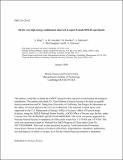On the very high energy confinement observed in super H-mode DIII-D experiments
Author(s)
Ding, S.; Garofalo, A.M.; Knolker, M.; Marinoni, Alessandro; McClenaghan, J.; Grierson, B.A.; ... Show more Show less
Download20ja045_full.pdf (1.805Mb)
Metadata
Show full item recordAbstract
Analysis of recent super H-mode experiments on DIII-D shows that high rotation, not high pedestal, plays the essential role in achieving very high confinement H98y2 > 1.5. Very high confinement is reached early on in the H-mode phase of these discharges, when the pedestal is still very low, but after the toroidal rotation has already built-up to very high levels in the core. As the discharge evolves, the rotation drops, and so does the energy confinement, despite a sustained very high pressure pedestal. During this evolution, the confinement quality is linearly correlated with the core toroidal rotation, which varies according to different levels of injected neutral beam torque per particle. Core transport modeling shows that the contribution from rotation in the E×B shear is responsible for confinement quality significantly in excess of standard H-mode (H98y2 ∼ 1).
Description
Submitted for publication in Nuclear Fusion
Date issued
2020-01Department
Massachusetts Institute of Technology. Plasma Science and Fusion CenterJournal
Nuclear Fusion
Publisher
IOP
Other identifiers
20ja045